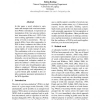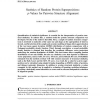221 search results - page 25 / 45 » Word Sense Disambiguation Using Pairwise Alignment |
EACL
2006
ACL Anthology
13 years 10 months ago
2006
ACL Anthology
In this paper a novel solution to automatic and unsupervised word sense induction (WSI) is introduced. It represents an instantiation of the `one sense per collocation' obser...
CICLING
2003
Springer
14 years 1 months ago
2003
Springer
We present an automatic method to disambiguate the senses of the near-synonyms in the entries of a dictionary of synonyms. We combine different indicators that take advantage of th...
CLEF
2009
Springer
13 years 9 months ago
2009
Springer
Abstract. The Robust-WSD at CLEF 2009 aims at exploring the contribution of Word Sense Disambiguation to monolingual and multilingual Information Retrieval. The organizers of the t...
CICLING
2007
Springer
14 years 2 months ago
2007
Springer
Distributions of the senses of words are often highly skewed. This fact is exploited by word sense disambiguation (WSD) systems which back off to the predominant (most frequent) s...
JCB
2008
13 years 8 months ago
2008
Quantification of statistical significance is essential for the interpretation of protein structural similarity. To address this, a random model for protein structure comparison w...


